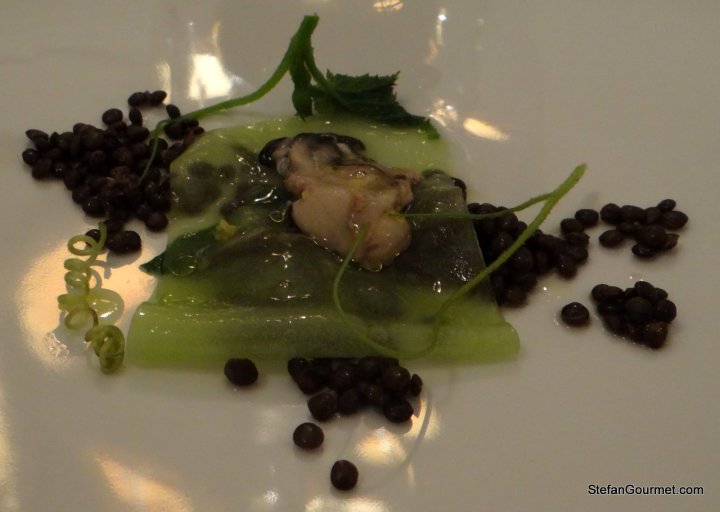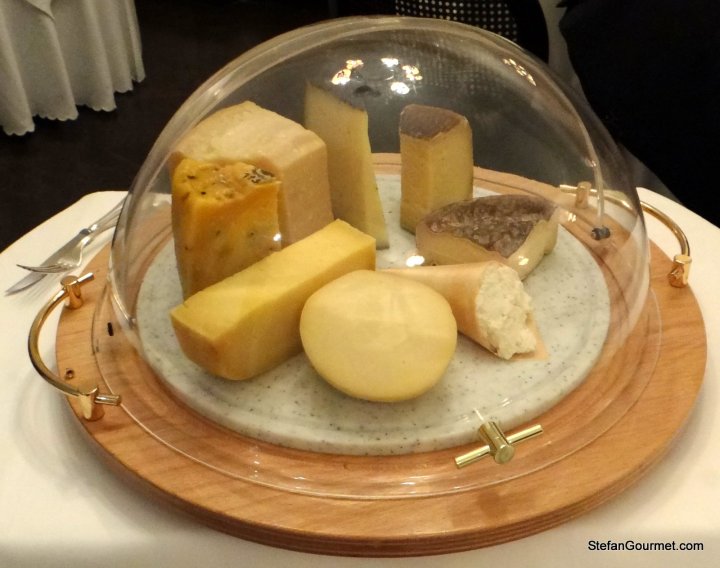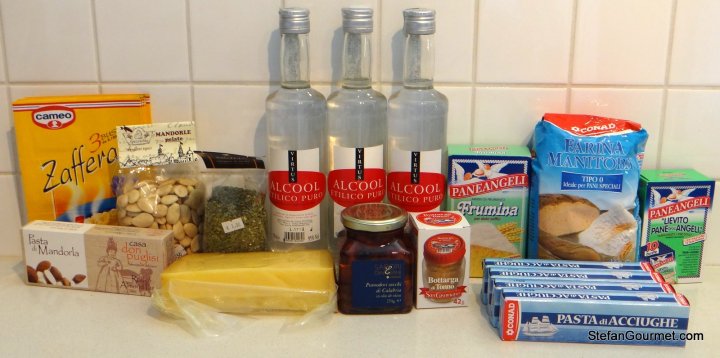
The final stop in our Sicilian food tour was La Gazza Ladra, a restaurant with one Michelin star located in the hotel Palazzo Failla in the Baroque town of Modica. The hotel and the restaurant are situated in a historic building.

On the Tuesday night when we visited there were only two other tables occupied in the classy dining room. The competition is stiff in this region of Silicy with La Madia and Il Duomo (in Ragusa) close by. The wonderful dinner we had at La Madia was a tough act to follow, and we only visited them in this order because that fitted with our itinerary. Besides à la carte there are two degustation menus, one for 80 euros and one for 95. As such, La Gazza Ladra is cheaper than La Madia and only half the price of Il Duomo. We picked the 8-course “Naturalmente” menu and were delighted when the sommelier Giovanni offered to do a course-by-course wine pairing with Sicilian wines. This is a treat that is not often available in Italy, where one usually has to make do ordering bottles.

Along with a nice glass of a chardonnay-based Sicilian spumante, there was pork crackling, pistachios and almonds.

With the nuts also came a small piece of focaccia.

The final amuse bouche was smoked eggplant, with the skin cooked very crispy.

Pala di ficodindia, ostrica e lenticchie nere. A slimy sheet made of cactus pear, with an oyster and black lentils. The minerals in the Etna Bianco that was served along with it paired very well with the oyster. An original dish consisting of components that each tasted fine and an interesting combination of textures, but the combination of flavors didn’t really do much for us. 7/10

Seppia alla piastra e “Piretto”. Squid that was first deconstructed and steamed, and then grilled on the piastra so that it has the flavor of grilled squid, but with a different (softer) texture. There was some fresh cedro (citron) as well, which had a very light citrus flavor. The wine pairing with an aromatic white again was good. I didn’t take notes and am not familiar enough with local Sicilian grapes to remember as much as I usually do. I thought the burnt flavor of the piastra was a bit overdone, overwhelming the flavor of the squid. 7/10

Uovo al parmigiano, pancetta e fave. A steamed egg with a crunchy almond crust, fava beans, crunchy pancetta, and parmigiano foam. A nice dish, but it lacked salt. The parmigiano foam was very light, and even the pancetta wasn’t very salty. 8/10

Mollica tostata, sarde e finocchietto. An interesting take on pasta con le sarde: the fried breadcrumbs were used to make the pasta dough, giving the pasta a different flavor and texture. There was a nice acidity to this, as if the sardines used were vinegared. Nice pairing with a Sicilian claret from nero d’avola (a claret is something in between rose and red wine, leaning more towards rose). The wine was perhaps slightly too fruity for the dish, but the sommelier deserves credit for this very adventurous pairing that otherwise worked very well. One of the best dishes of the evening in terms of flavor. 9/10

Tortelli di carruba all’arosto di maiale, erbe amaro e cumino. Tortelli made with flour of carruba and filled with a very nice pork filling. Paired well with a nice Sicilian red. After all those dishes with a very light flavor profile, this was a flavor bomb. It seems that primi piatti are the strong point of chef David Tamburini , as this was another good dish. 9/10

Pescatrice al limone, liquirizia e carciofi. Perfectly cooked tender monkfish with artichoke leaves and a sweet and sour sauce. Paired well with a catarratto from organic producer Barraco. The monkfish was really good, perhaps the best I’ve ever had, but I don’t get the combination with the sauce and the artichoke leaves. 8/10

Coniglio arrosto, cipollotto all’agro, olive e alloro. Roasted rabbit (leg, rack of rabbit, kidneys) with a scallion cooked in vinegar and olives.

We liked the idea of doing a tiny rack of rabbit so much that it deserves a close-up. The flavor and tenderness of the rabbit were not the best we’ve had. I don’t understand what the olives were doing on this plate. This was the only wine pairing of the evening that missed the mark: a white would have been better than a red given the light flavor of the rabbit. 7/10

Since we hardly touched the nero d’avola we got with the rabbit and had noticed the cheese dome all evening, we asked for some cheese outside of the menu to finish our wine.

1000 e una notte. The name of the dessert (1001 nights) refers to the arabic shape of what was introduced to us as semifreddo. The texture was different from usual semifreddo and the flavor was quite light. Again the sommelier did a good job pairing this with a Donnafugata Kabir, a light moscato di pantelleria that reminded me a bit of muscat de rivesaltes.

The Sicilian sweets that were served after the ‘semifreddo’ were a lot better, so I’m rating the whole dessert as 8/10.
The chef of La Gazza Ladra serves very original dishes with a great variety of textures. Technically almost everything was fine, but we didn’t fully appreciate all of the flavor profiles and combinations of flavors. Perhaps we are a bit spoiled after eating at quite a few of the best restaurants in the world with 2 or 3 Michelin stars. I would rate the food at La Gazza Ladra at 8/10, fitting for a 1 Michelin star.
Only after posting this review I found out that the chef has changed, as of 10 March 2013 the chef is now David Tamburini rather than Accursio Craparo. This also means that the ratings by Michelin and Gambero Rosso were based on a different chef. In the Gambero Rosso 2013 restaurant guide, Tamburini was still cooking for Casa Grugno in Taormina, and there had a rating of 49/60 for the food. The previous chef Accursio Craparo had a rating of 54/60 at La Gazza Ladra in that same guide. (The highest score for any chef in the 2013 guide is 57/60.)
The service was fine, which is easy if you have almost one server per table. 8.5/10
The real surprise of the evening was the wine. The sommelier Giovanni did a really good job of matching wines with the food. He seemed to be especially good at intuitively picking wines with aromas that match with the food. He also has great knowledge of Sicilian wines and could answer all of our questions. And so the level of the wines for us was above the rest and would have been fitting for at least a two-star restaurant, 9/10.
Coming soon…
And here ends my account of our trip to Sicily. But the fun isn’t over yet, because I now have lots of inspiration to cook Sicilian dishes over the next weeks that I will blog about. So you can expect to read about arancini (deep-fried breaded rice balls with ragù and peas), sarde a beccafico, busiate alla trapanese, pasta with mollica, and more Sicilian delights.

No this is not an ingredient lineup (what a strange dish that would be!), but the Italian goodies I brought home with me in my suitcase. I used the opportunity to acquire ingredients that are not as easily available in the Netherlands or not in the same quality. I brought the following:
- powdered saffron (easier to use than the threads we can get here and about half the price)
- Sicilian almond paste (pasta di mandorle) to make Sicilian almond pastries
- Sicilian almonds (more flavor than those available here)
- Sicilian oregano
- Ragusano, Sicilian cow’s milk cheese from Ragusa
- 95% proof alcohol to make my own limoncello (in Italy this is sold in any supermarket!)
- sun-dried tomatoes in oil (more flavor than those available here)
- bottarga
- anchovy paste (easier to use than anchovy fillets)
- wheat starch (amido di frumento)
- manitoba flour (‘strong’ but soft flour to make ciabatta, named after the Manitoba region in Canada where it originates)
- baking powder with vanilla aroma, used in many Italian recipes for pastries (lievito per dolci)
Since we were flying instead of driving, unfortunately I couldn’t take more.


Wat een genot om te lezen!
LikeLike
Hoi Melvin, leuk dat je een berichtje achterlaat!
LikeLike
Ciao Stephan, I really think you’re enjoing a lot in my beautifull country.
Bea
LikeLike
Ciao Bea, da sicuro! Non vedo l’ora fino alla prossima volta 🙂
LikeLike
Thanks for another great review!! When I was last there, I spent ages trying to find the Altamura flour to make Pane Nero di Altamura, but failed completely 😦
I did bring wild fennel seeds to try to grow at home, but they failed to germinate 😦
On the other hand, as you say, lots of memories and enthusiasm to try out different dishes!
LikeLike
Thanks for the nice compliment. I think the fennel seeds were supposed to be used as a spice? It is used for instance in finocchiona, a very nice salame.
LikeLike
Interesting meal… although not a lot looked especially appealing (a case of emphasizing form over substance, maybe?). The squid dish was intriguing though… I must try that idea of steaming before grilling sometime!
BTW … what is the object that the smoke eggplant is sitting on?
LikeLike
I think that form over substance may be an issue.
The ‘object’ is the crispy eggplant skin! It tasted better than eggplant skin usually does.
LikeLike
Thank you very much for visiting out restaurant. The nane of the chef is David Tamburini 🙂 http://www.ristorantelagazzaladra.it
LikeLike
Thanks for correcting my mistake. I had taken the name through Google from the website of the hotel at this address: http://www.palazzofailla.it/gazza.htm
Perhaps you should ask them to correct this.
LikeLike
What? Sicilians use Manitoba flour from western Canada? Now we’ll have to visit there, for sure! I was also surprised to learn the French (in France) use peas from western Canada to make their famous pea soup!
LikeLike
As many ‘traditional’ and famous dishes are less than 200 years old, it makes some sense that not only ‘mile 0’ ingredients are used. I guess that now there is also ‘Manitoba’ flour from wheat grown in other regions.
LikeLike